Anna Knox – 26 October, 2020
I think this cooperation and connection, necessary to sustain a terminal's life, is why airports remain such beautiful places—imperfect temples to humanity and its ingenuity. Places of blankness, disillusionment, control, sterility, and missed or denied connections: yes, certainly. But also places of freedom and successful connection, absent of borders while rigorously enforcing them.
Wellington
John Akomfrah, Ed Atkins, Marco Brambilla, Walead Beshty, Lauren Brincat, Thomas Demand, Simon Denny, Brian Eno, Charles and Ray Eames, Andreas Gursky, Naeem Mohaiemen, Adrian Paci, Alex Prager, Taryn Simon, and What We Found After You Left: A Project by 23 Greek Photographers Responding to Tripoli Cancelled.
Terminal
Curated by Aaron Lister
15 August, 2020 - 14 February, 2021
In August last year, a little over half a million people left Aotearoa for an international destination. This year? 14,310. Global air travel is suddenly, for most of us, a memory or a dream. But in New Zealand, at least, we can still go to an exhibition about it.
City Gallery Wellington’s Terminal effectively evokes the terminal and its sense of relentless, fluorescent wakefulness, but don’t expect to be fully transported. The exhibition isn’t a comprehensive meditation on either the airport experience, or the many subtexts of the terminal. While a terminal’s sterile and authoritarian aspects are well conjured, its more wabi-sabi attributes-the chaotic mingling, the dirt and grime, the intersecting histories, the jet-lagged people dreaming their collective dreams of escape and connection-are largely ignored.
That is, apart from John Akomfrah‘s The Airport, playing as one of two feature-length films in the ‘Departures’ section of the exhibition. This is an exceptional film, a work of sustained beauty in constant tension with pervasive ruin, and if you only have an hour at the gallery, you should spend it all on this.
The film is expansive in its vision, spanning decades, if not centuries, looking simultaneously to the past, the future and the present, and reflecting on the multiple stories, histories, promises and disappointments that a terminal space contains in a way no other can. The Airport is projected on three screens, which sometimes show different angles of the same scene, and at other times show different scenes entirely. An astronaut—or person dressed as an astronaut, or in any case someone vaguely alien—visits an abandoned airport in Athens, perhaps trying to understand what has happened.
Time is compressed and expanded as various ghosts, in full flesh but from other eras, move through the terminal in their own time, as if the airport had not fallen apart, silently telling their stories, while the pertinent soundtrack is broken up with broadcasts from past wars as well as from Greece’s more recent economic crisis and the protests and violence that accompanied it.
Akomfrah‘s visuals are exquisite, moving from the ruined insides of the terminal with its occasional forgotten passengers, to its dilapidated runway, to the surrounding hills and a small dilapidated village, to the sea and another seaside village, to an oil refinery. There is a romantic story playing out also, between the two most frequently seen characters, who change appearance and clothing with the ages, but appear to perhaps be the same people.
Stepping out of the ‘Departures’ lounge and into the ‘Arrivals’ section, Marco Brambilla’s film work Approach (1999) can be seen overhead. The piece, showing footage shot over fourteen hours in the arrivals hall of JFK International Airport, was an instant drawcard for me. I confess to being on the pro side of the Love Actually debate, and this reminded me of that film’s opening and closing sequences, but it’s far richer. Less of the happy-glow; more of the grit, fear, agony, emotion, and exhaustion of an arrivals hall. And on four screens, rather than one, with slight time lags between them, the disorientating effect is not unlike that emerging from a long-haul flight.
The remainder or the ‘Arrivals’ section is sparse, with only four works, including Brambilla’s, in the space. Not like a terminal at all, or not one with people in it, which I suppose is fitting for this moment.
The highlight here is Alex Prager’s Crowd 7 (Bob Hope Airport), a colour photograph (which is in fact a still from a film) reminiscent of the 1950s. The image is staged, and reads as such, with a cast of larger-than-life characters: A large man in the centre seemingly singing opera, another sitting on his suitcase with a book in one hand, an accusing woman with a red bag who stands glaring up at you.
The second part of the exhibition, ‘Screening’, is dominated by Ed Atkin’s disturbing video installation, Safe Conduct. In this ‘computer-generated, slapstick-horror-ballet-security-video’ (his words) which parodies airport security procedures, the process of screening becomes so physically intrusive that limbs are severed and scanned. Brains, bodies, blood, eyeballs, skulls, bones, scrotums, guns, and pineapples all make their way through the x-ray machine while a disturbing avatar with disfigured skin narrates to a dramatic soundtrack in crescendo.
I found it entertaining, but was put off by its rage at the rigmarole of security. It is intensely about what happens to me in the screening process, and about the invasiveness of that process. It decries an abuse of personal space, even though an intrusion of that space is undeniably part of the contract if you choose to participate in the luxury of international air travel.
As a point of irony, perhaps, there are no ‘take-offs’ in any of the ‘Take-Off’ section’s works; everyone is grounded, and none more so than the refugees in Adrian Paci’s haunting video work Centro di Permanenza Temporanea, which dramatizes exile and displacement as the men—whose faces we see in extreme close-up—are left stranded, mid runway, the plane pulling away and departing without them.
Naeem Mohaieman’s 2017 film, Tripoli Cancelled, which is showing three times daily in the Adam Auditorium, also touches in on the plight of refugees in an (until recently) extremely fluid world that nonetheless aggressively asserts the bordered framework of an earlier, less fluid era. Like Akomfrah’s, Mohaiemen’s film is also shot in Athens’ abandoned Ellinikon airport and follows the daily life of a man perpetually stuck there. The film is narrative-driven, humorous, and enriched in a heart-breaking way by the character’s narration of the letters he writes to his wife and son. Watching it was, in some contradictory way, liberating.
When watching Paci’s video work, on the other hand, I felt entrapped by a kind of numbness—quite the opposite of what being in a terminal usually makes me feel, which I suppose was the point. Collectively, the exhibition was leading me to conclude that today’s terminal is ‘terminal’ with the poisons of late capitalism—sterile authoritarianism, invasions of privacy, refugee crises, disconnection. (A critique on the environmental degradation of air travel was notably absent).
The last work I saw however, while possibly intending to double down on that conclusion, also suggested an alternative. In Düsseldorf, Flughafen II, Andreas Gursky’s sepia-toned and vast photograph, a man appears stranded on a runway, his tiny figure dwarfed by the scale of the picture and by the concrete rectangles and painted lines of the runway, as well as the city in the distance.
While the gallery’s commentary says that in Gursky’s photograph, ‘airports recur as agents of the borderlessness and time-space compression created by global capitalism,’ I immediately saw a portrayal of isolation and its futility. The man is nothing, alone in this monstrous landscape. For that landscape to mean anything, to function, requires enormous efforts of cooperation and communication, between many individuals, so that the large bullet-shaped hunk of metal can hurtle down the runway, and safely lift millions of people into the air, carry them across the world and set them down again. It takes a collective.
I think this cooperation and connection, necessary to sustain a terminal’s life, is why airports remain such beautiful places—imperfect temples to humanity and its ingenuity (we got ourselves to fly!). Places of blankness, disillusionment, control, sterility, and missed or denied connections: yes, certainly. But also places of freedom and successful connection, absent of borders while rigorously enforcing them.
An emphasis on the sterile aspects of air travel—the security infrastructure, the ‘dehumanising’ process of border controls, the blank spaces—such as what this exhibition focuses on, forgets this, and forgets that we are not just individuals forsaken in a hostile environment, but also a collective who created this environment and who continue to control it, for better or for worse.
Anna Knox
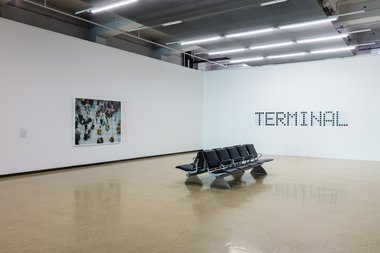
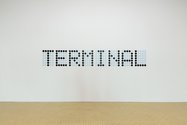
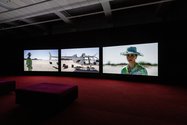
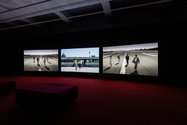
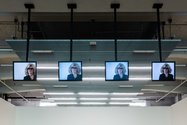

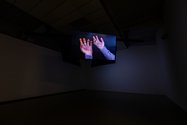
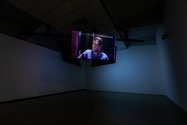
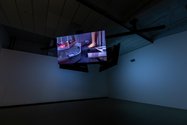


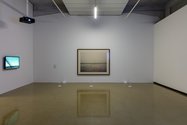

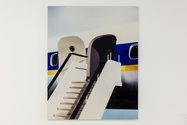
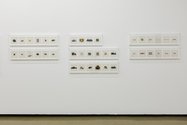
 Advertising in this column
Advertising in this column Two Rooms presents a program of residencies and projects
Two Rooms presents a program of residencies and projects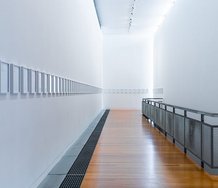
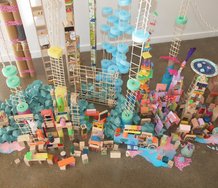
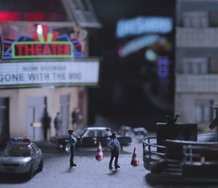
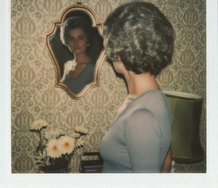
This Discussion has 0 comments.
Comment
Participate
Register to Participate.
Sign in
Sign in to an existing account.